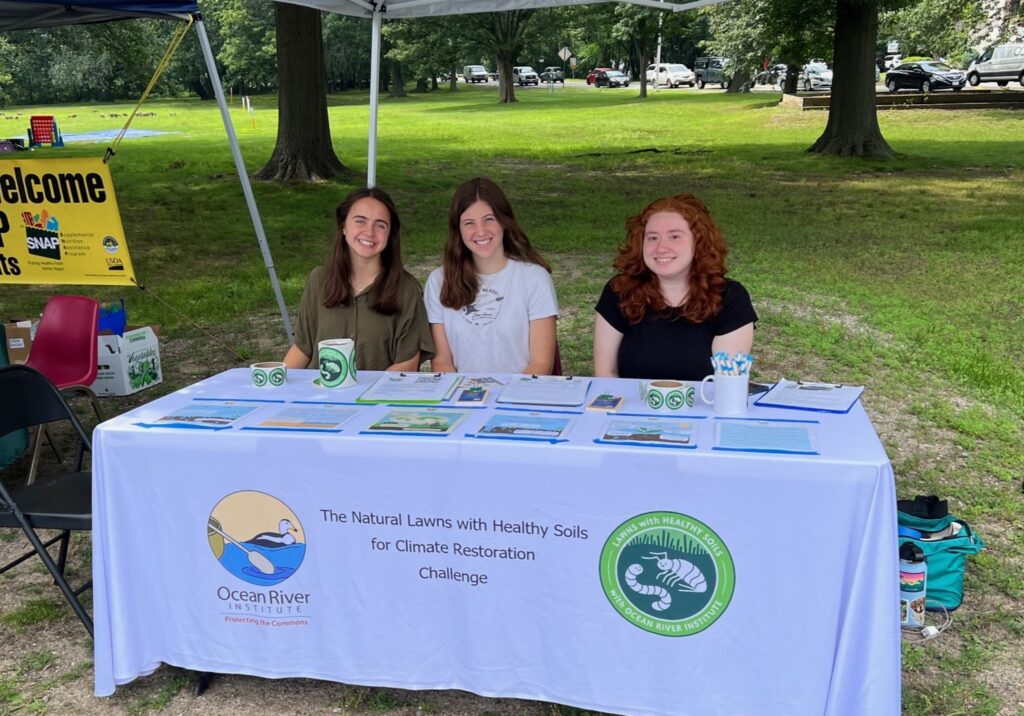Consider the Earth Rehydration Drought Relief Carbon Offset Fund to fight climate change, increase climate resiliency, minimize human environmental impacts, and restore nature. The fund takes a two-pronged approach.
The first part of the Fund focuses on slowing water down and restoring natural water cycles. In natural areas where the ground is covered in healthy soil, rainwater is naturally absorbed into the ground. Four inches of healthy soil can swell like a sponge to hold seven inches of rainwater. The water not used by plants in the soil trickles down into deep groundwater aquifers to recharge streams and rivers during dry months. As the water moves through the soil, contaminants and pollutants are filtered out, leaving the groundwater clean and safe.
Unfortunately, human development has disturbed this natural water cycle. In urban areas, buildings, highways, and other impervious surfaces prevent water from infiltrating into the ground. When it rains, water runs directly into rivers, lakes, and the ocean, and groundwater aquifers are never replenished.
Our disruption of the water cycle has numerous negative consequences. Areas with large amounts of impervious surfaces are at high risk of flooding. During large rainstorms, water builds up and pools on impervious surfaces, causing floods and property damage. Additionally, groundwater aquifers are running dry since no water can infiltrate and recharge them. This increases drought vulnerability since there is no longer a store of water to recharge rivers during dry periods. As groundwater stores continue to be depleted, all the extra water runs straight into rivers, lakes, and, eventually, the ocean, contributing to rising sea levels. Since this water is not being cleaned by infiltrating the soil, it brings pollution and contaminants into our waterways.
The Earth Rehydration Fund seeks to address runoff problems and decrease groundwater recharge by incentivizing property owners to install green infrastructure. The grant program would accept applications from residents interested in installing rainscapes on their property and provide financing for approved projects. Rainscapes are landscapes specifically designed to absorb rainwater into the ground or catch and hold it.
Property owners can choose from conservation landscaping, a native plant garden that absorbs water. Green roofs are roofs covered with soil and plants that soak up water. Permeable pavers provide a hard surface that can also infiltrate water into the ground. Pavement removal replaces an impervious surface with soil and plants. Rain gardens have a depressed area where rain can gather and slowly seep into the ground. Rain barrels and cisterns collect rainwater off the roof of a house and temporarily store it.
Community groups may also receive grants to collaborate, as they did in Cambridge, to create the Griffith Park forest in only 1,000 square meters. Due to the many different native species planted close together, this is a Miyawaki forest. Pocket forests like this, often placed in degraded landscapes, develop faster than natural or plantation forests. The stand is resilient to climate change, holds more water, supports more wildlife, and is a place of peace for people.
The second part of the Earth Rehydration Fund focuses on natural lawns, which store carbon in healthy soil. Soil has a remarkable capacity for long-term carbon storage. Globally, the world’s soils already hold over 2800 billion tons of carbon, while the world’s above-ground biomass (all plants and trees) contains only about 564 billion tons of carbon. When plants photosynthesize, they take carbon dioxide from the atmosphere and manufacture carbohydrates, sugars, and lipids. Plants push liquid carbon out of the roots, stored in healthy soil. While most plants put about 33% of their carbon into the soil, grasses excrete 50% of their total carbon, so they are incredibly effective at storing soil carbon. Once the carbon is put into the soil, it goes through a chemical process and becomes humus, which stores carbon for thousands of years.
The Earth Rehydration Fund will capitalize on the ability of healthy soils to store carbon by incentivizing people to manage their lawns naturally. A natural lawn is one without fertilizer, pesticides, or herbicides. Fertilizing a lawn enables the grass to find all its nutrients at the soil’s surface, which creates shallow root systems that are worse at sequestering carbon and make the grass more vulnerable to drought. Pesticides and herbicides kill soil life, diminishing microbial diversity and disrupting crucial nutrient cycling. Natural lawn practices allow grass to build healthy soil that holds large amounts of carbon while increasing wildlife values to the yard.
The Earth Rehydration Fund will work by paying residential lawn owners who pledge not to use quick-release fertilizers, pesticides, or herbicides on established lawns. The fund improves lawn management practices that build healthy soil, store more carbon, retain more water, and help fight climate change.
The Earth Rehydration Drought Relief Carbon Offset Fund incentivizes environmentally friendly landscaping practices to address some of the most significant and most pressing environmental issues of our time, such as loss of healthy soils, degraded local water cycles, polluted landscapes, harmful algae blooms, and climate change. The Fund capitalizes on nature-based solutions to give people the resources they need to become more effective environmental advocates in their backyards.
Morgan Owens, the co-author of this article, is an Ocean River Institute 2023 Summer Intern and a rising Junior at Tufts University. Morgan was capably assisted by interns Megan Mathieu (Tufts) and Sabrina Machtay (Brandeis).
Photo: Megan Mathieu, Morgan Owens, and Sabrina Machtay, ORI Summer Interns educational outreach at Medford Farmers’ Market.



Our client needs funding for a groundwater recharge project. Could the project be eligible to receive carbon offset money through the energy saved by replacing water otherwise transferred to Southern California?
Even in California I image carbon offset money is very scarce. Groundwater recharge projects are most rewarding because water will be available locally during dry periods. BRAVO More rehydration of the Earth is the fastest way to address climate change because with adequate water plants grow, drawing down more CO2 and storing carbon for thousands of years in soil, the world’s carbon sink.